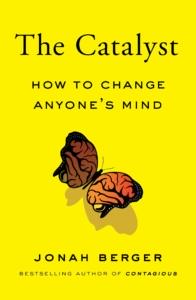The Catalyst
How to change anyone´s mind
Jonah Berger, 2020
Why Reading
It´s well known that it can be hard to change people´s (and thus organisations) opinions, mindset and way of working. However, the understanding of why it´s difficult and ways to progress has been scarce. This book gives us exactly that. Through story telling showing us that it is removing roadblocks rather than persuasion that will make people change.
Reading tips
- Chapter 1 shows how trying to push things and thoughts on people often trigger negative reactions. We need to provide a menu of options, identify gaps and ask questions so that people instead are enabled to convince themselves.
- Chapter 2 is about the difficulty of breaking habits. We are taught ways to make the status quo look too costly through surfacing the cost of inaction.
- In Chapter 3 distance as a barrier to change is visualised through the metaphor of a football field. You need to be in the zone of acceptance instead of the region of rejection to be able to change. Through asking for less and find the movable middle field.
- Chapter 4 describes how uncertainty is a clear blocker to change. And how approaches such as possibility to try things out, getting a free start period/version and making the process reversible can enable successful change.
- Chapter 5 points to the difficulties with adds campaigns and commercials to change strong beliefs. In these cases, evidence coming from friends, co-workers etc. becomes crucial to trigger that change. The more evidence the higher likelihood for change.
- The epilogue summarizes the book in the REDUCE roadblocks approach, that enables really anyone to become a catalyst for change.



